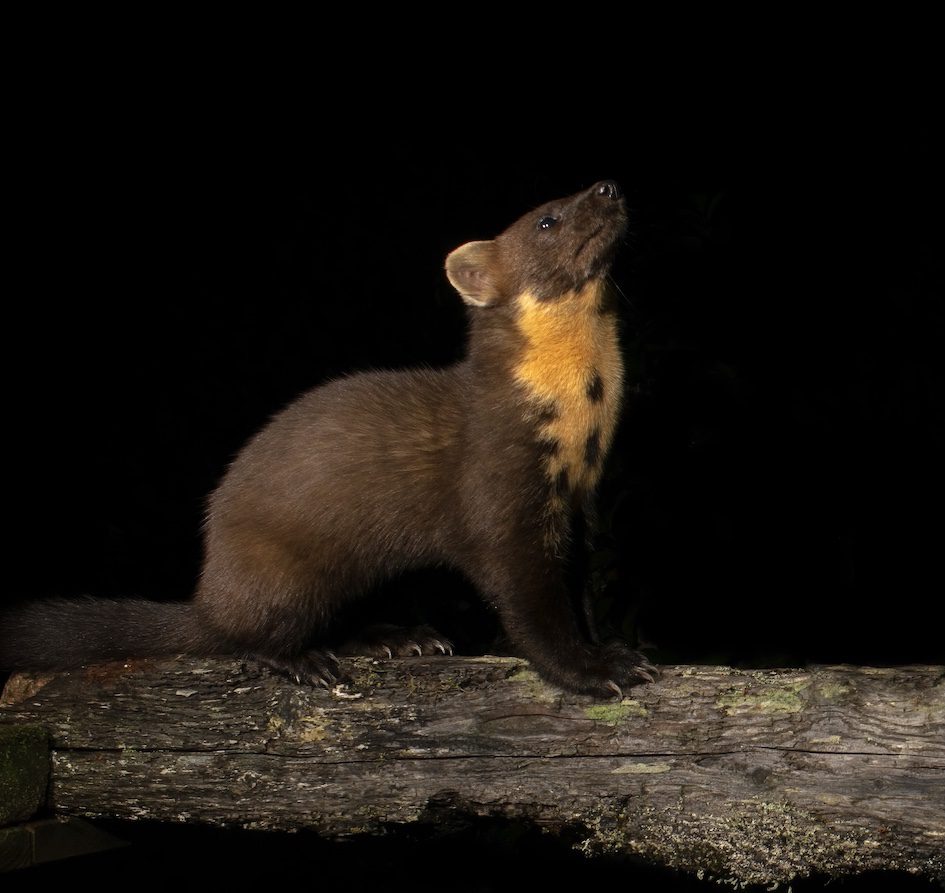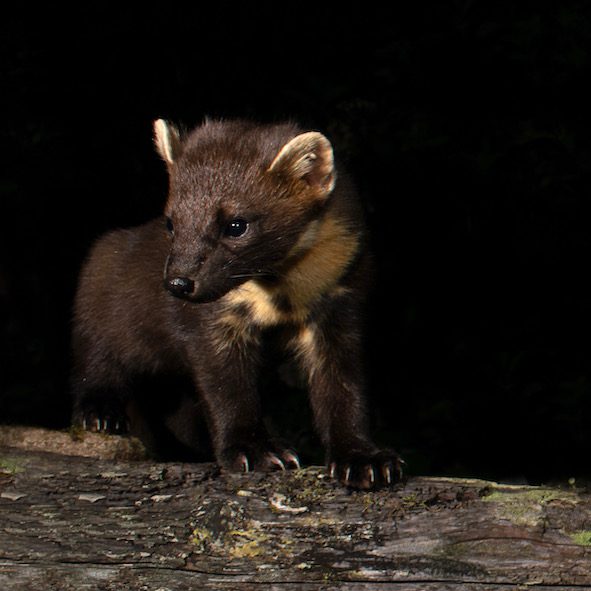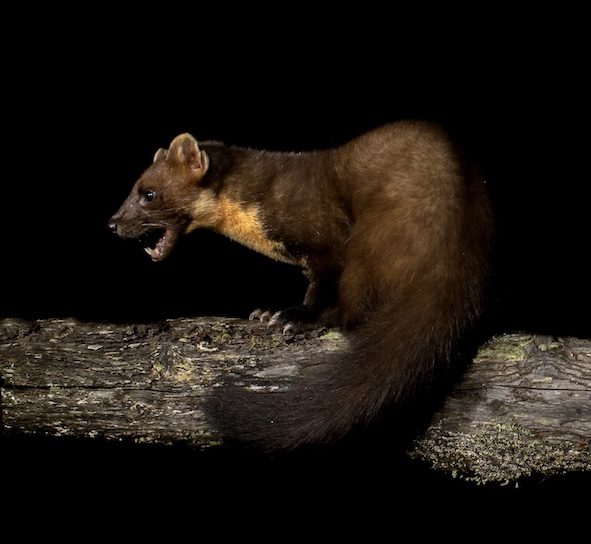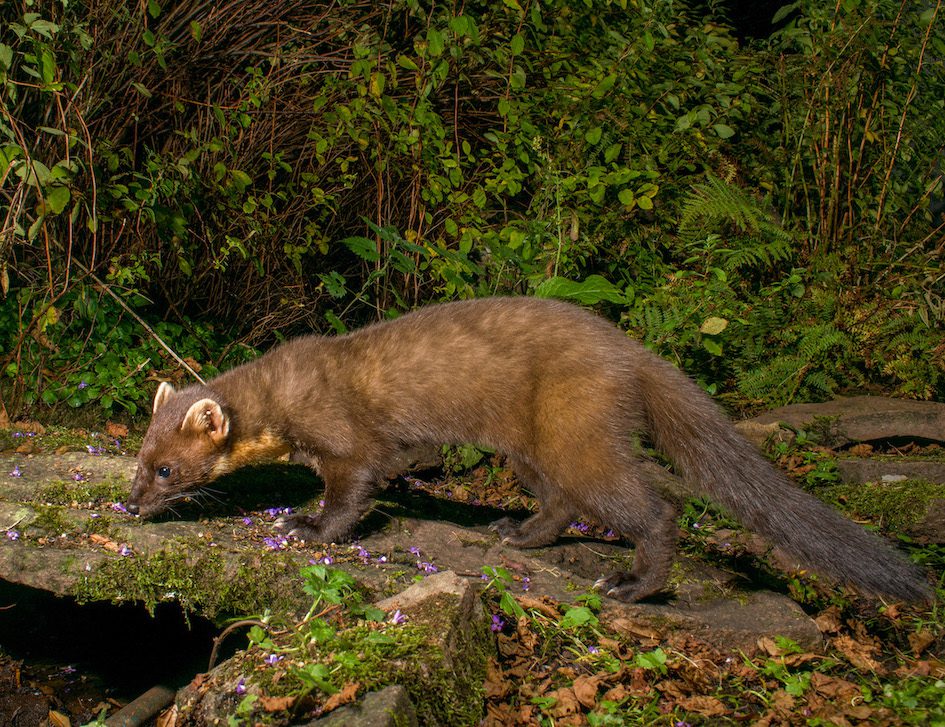By Ed Snell, Project Officer – Yorkshire Pine Marten Project (July 2020)
This factsheet covers key information about pine martens through a Q&A, with topics including their current status in Yorkshire, diet, habitats and practical advice for gamekeepers and other landowners.

Pine martens are a mustelid that’s similar in size to a small house cat. They have a distinctive creamy-yellow bib, light to dark brown fur and a bushy tail. They’re excellent climbers, spending much of their time in forest habitats, where their varied diet includes small mammals, birds, insects and fruit. Pine martens are a common species throughout Europe and increasingly so in Scotland, yet they’re sparse in number throughout England.
In recent years pine martens have seen increasing conservation interest throughout the UK as we’ve begun to understand their important value to a healthy woodland ecosystem. Recent research suggests that pine martens are an important ally to our dwindling red squirrel population, as pine martens prey on the invasive grey squirrels that out-compete and spread the squirrel pox virus to our native red squirrels.
The charismatic yet secretive behaviour of pine martens has also driven public interest as they’re a fascinating and rare species to observe. There have been recent translocations of pine martens from Scotland to England and Wales to help boost their numbers in places such as the Forest of Dean and in mid-Wales, and there are various projects underway to understand their population status, such as NatureSpy and Forestry England’s work with camera trap surveys in Yorkshire.
Why are there so few pine martens in England?
Historically, pine martens were heavily hunted; shot for sport, hunted for fur and persecuted as a pest by landowners. Additionally, they rely on woodland habitats for survival, 95% of which had disappeared in England by 1900. Pine martens live in low population numbers, so the aggressive hunting of them in England throughout the 19th century, coupled with loss of habitat, has meant they have struggled to survive in England.
Pine martens are now a protected species in the UK under the Wildlife and Countryside Act, 1981. This means it is an offence to intentionally or recklessly kill, injure or capture a pine marten; disturb a pine marten den; or, damage, destroy or obstruct access to a pine marten den. Pine martens are also a priority species under the UK Post-2010 Biodiversity Framework.
What’s the current status of pine martens in Yorkshire?
Survey work carried out by NatureSpy and Forestry England suggests that pine marten numbers are very low in Yorkshire. The last confirmed photographic evidence of pine marten living in Yorkshire was in 2017. There are occasional reported sightings from members of the public, however it is difficult to confirm the reliability of these sightings without photographic or genetic evidence as the species can be commonly mistaken for other mustelids (e.g. polecats and stoats).


What is a pine martens’ diet?
Pine martens have a varied, omnivorous diet. For example, a 2019 study of female pine martens denning in Galloway Forest in Scotland (which is of similar composition to Forestry England sites in Yorkshire) found that small mammals made up around 35% of their diet, birds, insects and plants made up around 15-20% each and amphibians account for around 10%.
What kind of habitats do pine martens live in?
The most important habitat for a pine marten is woodland, as they rely on dens and resting sites that are elevated off the ground, away from predators, typically in the cavities of trees. Woodlands are also where they find most of their varied diet. Research has shown that, although their name suggests an affinity for trees, pine martens do benefit from a range of more open habitats too, such as grasslands where small mammal prey such as field voles can be abundant.
What are the chances of seeing a pine marten in the wild?
Healthy populations of pine martens live in low numbers as they are a highly territorial species, actively excluding other pine martens from the area. Their territories range from around 200 to 3,000 hectares, so the likelihood of seeing a pine marten is very slim, even in areas where they are in healthy numbers.
Are pine martens a predatory threat to game and poultry?
Pine martens will prey on game and domestic fowl, however, there are highly effective practical measures that can reduce the risk of this happening, including: electric fencing; ensuring a pen has no holes bigger than 45mm; and, preventing access via tree branches by creating a gap of at least 3m between the top of the pen and the tree canopy. The Vincent Wildlife Trust have published instructions on how to include these features in pens.
Where pest control is in place, how do you avoid trapping pine martens?
Pine martens can get through 45mm diameter gaps, so trap excluders should be smaller than this. Live capture traps should be checked every 4 hours between March and June when female pine martens have dependent kits, and at least once every 12 hours throughout the rest of the year.
If you’ve seen a pine marten in Yorkshire, please report this to NatureSpy. Where possible, NatureSpy will investigate reported sightings further with surveys and searches for field signs of pine martens. Any information about pine marten whereabouts in Yorkshire can be vital for understanding more about the species and assist with effective conservation of pine martens regionally.

This factsheet has been prepared with the following resources:
Photos by Tom Broxup.
‘Pine martens’ by Johnny Birks, Whittet Books
‘The return of pine martens to England’s forests’ – Forestry England
‘Resources for gun clubs and poultry keepers’ – Vincent Wildlife Trust
Caryl et al, 2012. ‘Martens in the matrix: the importance of non-forested habitats for forest carnivores in fragmented landscapes’
Grabham et al, 2019. The diet of denning female European pine martens (Martes martes) in Galloway Forest District, South West Scotland, Great Britain.